This post contains affiliate links. We may get paid an affiliate commission if you buy something or take an action after clicking one of the links on this web page.
Last Updated: March 7, 2021
Over the last few years, pro-knife legislation in many states has contributed to a renewed interest in automatic knives. In part, these laws recognize the futility of banning automatic knives (also known as switchblades) when modern folders can be deployed just as quickly. The advent of the frame lock flipper begs the question: when manual knives can be reliably deployed at the same speed, but don’t require as many moving parts, is there still a justification for automatic knives? I argue that there is, but we’ll get to that later on.
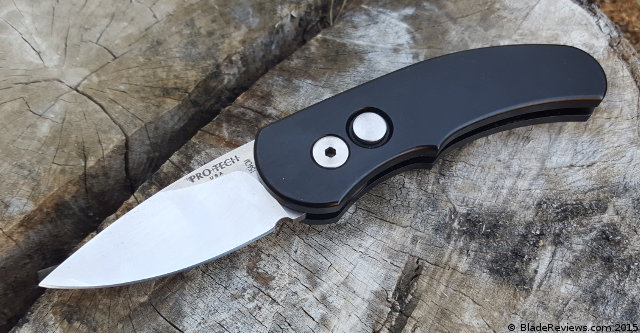
Buy the Protech Runt at BladeHQ
Although several states have passed laws which legalize carrying automatic knives, others have not. My home state of California still bans the carry (but not ownership) of switchblades. However, the California penal code does not define automatic knives with blades less than two inches as switchblades, which has created a market for tiny automatics.
Apart from smoke shop specials, few manufacturers cater to this niche market. Benchmade and Microtech each have an offering, but I wasn’t impressed by either during my (admittedly brief) handling period. While I can’t speak for everyone’s taste, I can say that I’m glad I chose the Protech Runt J4. Pro-Tech has a robust selection of CA-legal autos. They are based in California, after all. They also have earned a reputation online for quality manufacturing practices.
General Dimensions and Blade Details
The Protech Runt J4 has a 1.94 inch blade, a closed length of 3.33 inches, an overall length of 5.27 inches, weighs just 2.1 ounces, and is made in the USA. I chose the spear point blade, although there is the option of a tanto, if you’re so inclined.
On this model, Protech uses 154CM blade steel, which is fairly typical choice along the Pacific coast. I’ve heard that 154CM was originally developed for the aerospace industry, and if so, some of its popularity in California would be partially explained. If anyone has more information, please leave it in the comments. 154CM is an excellent working steel: passably tough, stainless, with good edge retention and easy sharpening. Some may criticize it for its edge retention when compared to the new generation of super steels, but it has held its own (both on this knife and others) in my experience.
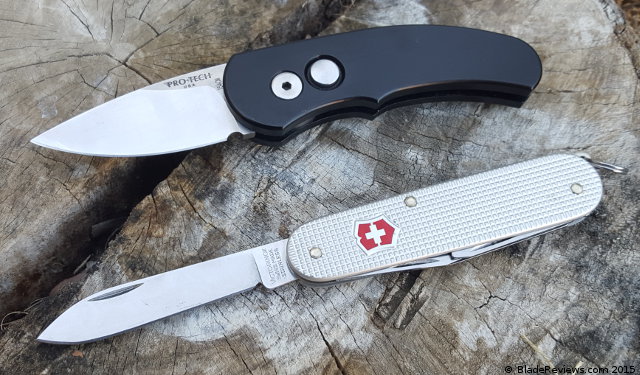
The blade is thinly ground, but the tip geometry is not as delicate as it appears. It is at least as tough as that of the Spyderco Dragonfly II. So long as you don’t drop it onto concrete, the blade should hold up fine. Between the thin stock and the high flat grind, the Runt is one of the best cutters I have owned. However the short blade makes certain tasks (among them slicing fruit – you only bite into an earwig in your apple once) slightly onerous, and some of the slicing potential is wasted on the short blade.
To date, rust has not been an issue, but others have had poor experiences with 154CM. The credit in this case should (in my opinion) go to the lustrous satin finish Protech put on the blade. Although the photographs don’t showcase it very well, this is one of the nicest finishes I’ve seen, and the satin finish on the main bevel is complemented by a high polish stonewash on the flats.
Handle, Ergonomics, and Carry
When this knife arrived, I assumed that the “fidget factor” of the knife would lie in deployment – that is, after all, the allure of an automatic knife. I was surprised to find that it was just as pleasant to the touch as my traditional knives. While it lacks the organic feel that micarta does, the aluminum (which has been hard anodized to the HAIII rating) is smooth and lustrous, akin to obsidian. The finish has held up well to riding next to a pen and a light, although it is fading at certain contact points. Rubbing against knurled titanium will have that effect, and I’m honestly surprised at how resilient the finish is. I’m certain that more of the coating will chip or wear away over time, but that isn’t the biggest concern for me. Much like the patina on a traditional knife or the fading on good jeans, this wear is a sign of use and adds a level of character that it would not have were it pristine.
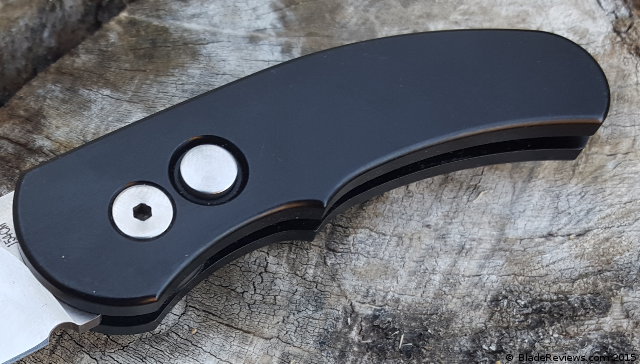
In the hand, the knife is comfortable, but I would not suggest it for hard use, or cutting for long periods of time. While there is technically enough room on the handle for four fingers, this is meant to be a three finger knife. To Protech’s credit it is a well-executed grip, and despite the lack of jimping I’ve never worried about my fingers sliding onto the blade (or dropping it, for that matter). A lanyard hole would be a great addition and allow the knife to have a pseudo four finger grip. The edges have all been nicely chamfered, which gives the knife some of that “warm” feeling I often see attributed to custom knives, and is a contributing factor in stopping me from obsessively firing the Runt repeatedly as some do with flippers.
The one issue that I truly have with this knife is how it carries, and before you ask, it’s not because it is tip down only. Would I like to have the option? Yes, and I see no reason why Protech didn’t tap the other end of the handle to accommodate it. As I carry this knife next to a small flashlight, I don’t mind tip up, as it plays nicer with other stuff clipped to my pocket. I do not like the clip, however. The tension is unnecessarily stiff and the lip is too low to reasonably slide onto thicker cloth. And if you notice farther down, two of the clip screws (the ones on the outside were borrowed from another knife) needed to be replaced, as the originals stripped almost immediately.
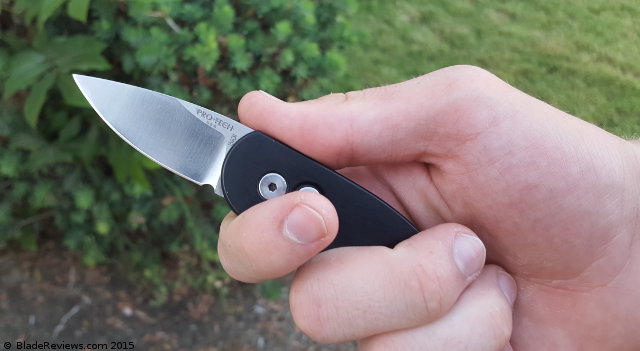
Deployment and Lockup
Of course, the deployment is the main reason many folks consider an automatic knife. Whether they want to feel like Batman, need a knife that reliably deploys on command, or simply admire the mechanical ingenuity, let’s be honest: the thwack you get after pushing the button is addicting. The high polish on the button (which is both the deployment method and lock release) invites this sort of behavior, despite the nasty and/or frightened looks you may receive. After reading Anthony Sculimbrene’s review of the Protech Sprint (a newer, smaller model) wherein he noted that the small handle made it difficult to keep your grip on the knife when it deployed, I decided to go for the Runt instead, and I’m glad I did. The Runt fires louder and with more force than any automatic knife I’ve handled, which happens to be quite a few after a trip to a wonderfully seedy Las Vegas knife store. For some, this will be a real detriment. Not only does it draw attention to the knife, but you may lose your grip if you aren’t expecting it. After owning this knife for seven months or so, I’ve dropped it once for just that reason. In the Runt’s defense, I was absentmindedly firing it while doing some research, so that may be due to human error.
This was my first button lock, and I have no complaints. I can easily open and close the knife and the lock has zero blade play in any direction. Although there is no secondary lock or safety feature to prevent the knife from opening accidentally, I don’t think one is necessary here. Despite my initial concerns that the placement of the firing button/lock interface would lead to inadvertently releasing the lock (see the earlier grip shot), it was never an issue in realistic use. The plunger is deep enough that barring truly extraordinary circumstances, your index finger won’t come close to compromising the lock. The Runt has never fired in the pocket, and I was not able to induce the knife to open in such conditions.
I did have to apply Loctite to the pivot screw on mine, but when I did, I realized the screw was as thick as those on some of the “hard use” knives I’ve handled. Some folks might balk at the relatively complex internals of a button lock, but as the guys at the Knife Thursday podcast went over, having a lot of parts isn’t necessarily a bad thing. For example, on a framelock (or God help you, an integral) if the lock is somehow compromised and needs to be replaced, then the entire lock side of the knife needs to be replaced as well. On a button lock or an axis lock, parts will fail, but typically can be fixed without too much hassle, as the offending component is just one part of the mechanism.
Protech Runt J4 Review – Final Thoughts
Ultimately, if you are legally able to carry an automatic knife and are interested in doing so, I would recommend you first look at Protech. If my experience with the Runt and the hype on internet forums is representative of their capabilities, you won’t be disappointed. It’s not just good in the niche role of California legal automatics, it’s a great knife for everyday carry. This knife is impeccably finished, significantly nicer than its competition, and costs far less to boot. Keep in mind, the Runt is not without its problems. It can be a pain to carry it using the pocket clip. The deployment can require some getting used to, and its less people friendly than its size would indicate. However, if you’re looking for a classy knife that is equally at home on the job site and in a suit, this is an option worth exploring.
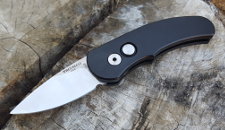
Protech Runt – From $105.00
From: BladeHQ
I recommend purchasing the Protech Runt at BladeHQ or possibly Amazon (as available). Thanks for reading.
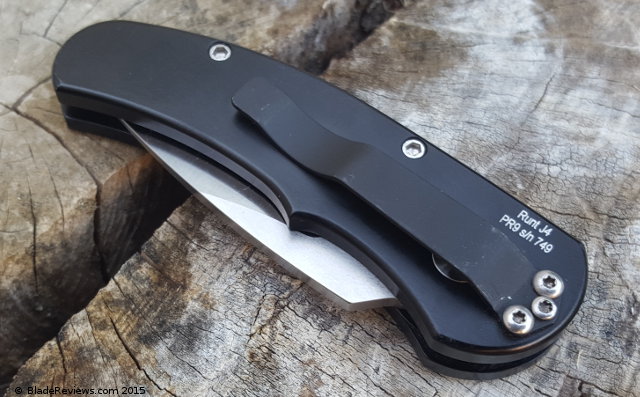
I purchased one of these about 2-3 years ago. My biggest regret is that i didn’t realize it was tip-down carry when i ordered it. My goal was to put a lanyard on the pocket clip (since there is no hole) to help lengthen the grip. Of course this will not work with a tip-down orientation. In the end, i opened the knife a few times, said looks cool and it has never been touched since 🙁
JD
Hey JD,
I can see that being a pain. I don’t mind tip down, as it plays nicer with the pen and light I’ll inevitably have in my pocket. I also tend to carry it alongside a traditional folder or Swiss Army Knife, so the short grip is never a huge deal – I’ll use it for a quick cut and put it away. If I need to use a knife for longer tasks, I’ll break out the traditional folder. Give yours another go, it’s not helping anyone sitting in a drawer!
Thanks for the comment,
-Grayson
I got my first Runt years ago and then two years ago added several more plus a Sprint which is also one of their under 2″ automatic knives. They’re exquisite and handy. Nice for the watch pocket. The black serrated below is the oldest.
Protech Runt J4 Black Handle Black Serrated
Protech Runt J4 Silver Handle Black Plain
Protech Runt J4 Maple Burl Handle Black Plain
Protech Runt J4 Silver Handle Satin Plain
ProTech Sprint Black CF Black Plain
Hey Ramin,
That’s quite a collection you’ve got! Have you seen the new “Jazz” coloration they’re offering? It’s a smoky blue/black, you may want to check it out.
Thanks for the comment!
-Grayson
Thanks for the review! I particularly appreciated your comments on the “feel” of the aluminum. I have avoided some aluminum knives that I’m really interested in because I’ve never handled one in person and I was afraid aluminum would feel too much like ss handled knives – I HATE the way ss handles feel.
Based on your description, I may have to pull the trigger on one of the aluminum knives I have my eye on.
Hey Ameer,
Glad to see you over here! I was hesitant about aluminum as well, but it’s grown on me considerably. The wear it accumulates at contact points is truly beautiful, in my opinion. I don’t know what ss handles you experienced, so unfortunately I can’t tell you if you’ll experience a similar tactile feeling. I know that I like it, even though it is slick.
Thanks,
Grayson
What is the difference b/w the Benchmade Lerch and the Protech Runt. The BM run higher. Is it the blade material. I assume both companies bought the rights from the same designer.